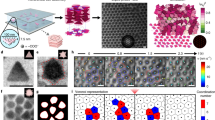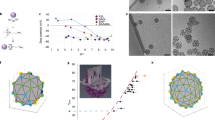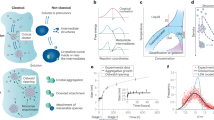Abstract
Viscoelastic phase separation of colloidal suspensions can be interrupted to form gels either by glass transition or by crystallization. With a new confocal microscopy protocol, we follow the entire kinetics of phase separation, from homogeneous phase to different arrested states. For the first time in experiments, our results unveil a novel crystallization pathway to sponge-like porous crystal structures. In the early stages, we show that nucleation requires a structural reorganization of the liquid phase, called stress-driven ageing. Once nucleation starts, we observe that crystallization follows three different routes: direct crystallization of the liquid phase, the Bergeron process, and Ostwald ripening. Nucleation starts inside the reorganized network, but crystals grow past it by direct condensation of the gas phase on their surface, driving liquid evaporation, and producing a network structure different from the original phase separation pattern. We argue that similar crystal-gel states can be formed in monatomic and molecular systems if the liquid phase is slow enough to induce viscoelastic phase separation, but fast enough to prevent immediate vitrification. This provides a novel pathway to form nanoporous crystals of metals and semiconductors without dealloying, which may be important for catalytic, optical, sensing, and filtration applications.
This is a preview of subscription content, access via your institution
Access options
Access Nature and 54 other Nature Portfolio journals
Get Nature+, our best-value online-access subscription
$29.99 / 30 days
cancel any time
Subscribe to this journal
Receive 12 print issues and online access
$259.00 per year
only $21.58 per issue
Buy this article
- Purchase on Springer Link
- Instant access to full article PDF
Prices may be subject to local taxes which are calculated during checkout






Similar content being viewed by others
References
Glickman, T. S. & Zenk, W. Glossary of Meteorology (American Meteorological Society, 2000).
Morrison, H. et al. Resilience of persistent arctic mixed-phase clouds. Nat. Geosci. 5, 11–17 (2012).
ten Wolde, P. R. & Frenkel, D. Enhancement of protein crystal nucleation by critical density fluctuations. Science 277, 1975–1978 (1997).
Sear, R. Nucleation: theory and applications to protein solutions and colloidal suspensions. J. Phys. Condens. Matter 19, 033101 (2007).
Savage, J. R. & Dinsmore, A. D. Experimental evidence for two-step nucleation in colloidal crystallization. Phys. Rev. Lett. 102, 198302 (2009).
Vekilov, P. G. The two-step mechanism of nucleation of crystals in solution. Nanoscale 2, 2346–2357 (2010).
Palberg, T. Crystallization kinetics of colloidal model suspensions: recent achievements and new perspectives. J. Phys. Condens. Matter 26, 333101 (2014).
Anderson, V. J. & Lekkerkerker, H. N. W. Insights into phase transition kinetics from colloid science. Nature 416, 811–815 (2002).
Lekkerkerker, H. N. W. & Tuinier, R. Colloids and the Depletion Interaction Vol. 833 (Springer Science Business Media, 2011).
Poon, W. C. K. The physics of a model colloid–polymer mixture. J. Phys. Condens. Matter 14, R859–R880 (2002).
Zaccarelli, E. Colloidal gels: equilibrium and non-equilibrium routes. J. Phys. Condens. Matter 19, 323101 (2007).
Piazza, R. & Di Pietro, G. Phase separation and gel-like structures in mixtures of colloids and surfactant. Europhys. Lett. 28, 445–450 (1994).
Verhaegh, N. A. M., Asnaghi, D., Lekkerkerker, H. N. W., Giglio, M. & Cipelletti, L. Transient gelation by spinodal decomposition in colloid–polymer mixtures. Physica A 242, 104–118 (1997).
Lu, P. J. et al. Gelation of particles with short-range attraction. Nature 453, 499–503 (2008).
Tanaka, H. Viscoelastic model of phase separation in colloidal suspensions and emulsions. Phys. Rev. E 59, 6842–6852 (1999).
Tanaka, H. Viscoelastic phase separation. J. Phys. Condens. Matter 12, R207–R264 (2000).
Krall, A. H. & Weitz, D. A. Internal dynamics and elasticity of fractal colloidal gels. Phys. Rev. Lett. 80, 778–781 (1998).
Solomon, M. J. & Varadan, P. Dynamic structure of thermoreversible colloidal gels of adhesive spheres. Phys. Rev. E 63, 051402 (2001).
Romer, S., Scheffold, F. & Schurtenberger, P. Sol–gel transition of concentrated colloidal suspensions. Phys. Rev. Lett. 85, 4980–4983 (2000).
Pusey, P. N., Pirie, A. D. & Poon, W. C. K. Dynamics of colloid–polymer mixtures. Physica A 201, 322–331 (1993).
Ilett, S. M., Orrock, A., Poon, W. C. K. & Pusey, P. N. Phase behavior of a model colloid–polymer mixture. Phys. Rev. E 51, 1344–1352 (1995).
Foffi, G. et al. Phase equilibria and glass transition in colloidal systems with short-ranged attractive interactions: application to protein crystallization. Phys. Rev. E 65, 031407 (2002).
Buzzaccaro, S., Rusconi, R. & Piazza, R. Sticky hard spheres: equation of state, phase diagram, and metastable gels. Phys. Rev. Lett. 99, 098301 (2007).
Testard, V., Berthier, L. & Kob, W. Influence of the glass transition on the liquid–gas spinodal decomposition. Phys. Rev. Lett. 106, 125702 (2011).
Royall, C. P., Williams, S. R., Ohtsuka, T. & Tanaka, H. Direct observation of a local structural mechanism for dynamic arrest. Nat. Mater. 7, 556–561 (2008).
Poon, W. C. K. et al. Colloid–polymer mixtures at triple coexistence: kinetic maps from free-energy landscapes.. Phys. Rev. Lett. 83, 1239–1242 (1999).
Tanaka, H. & Nishi, T. New types of phase separation behavior during the crystallization process in polymer blends with phase diagram. Phys. Rev. Lett. 55, 1102–1105 (1985).
Soga, K. G., Melrose, J. R. & Ball, R. C. Metastable states and the kinetics of colloid phase separation. J. Chem. Phys. 110, 2280–2288 (1999).
Charbonneau, P. & Reichman, D. Systematic characterization of thermodynamic and dynamical phase behavior in systems with short-ranged attraction. Phys. Rev. E 75, 011507 (2007).
Fortini, A., Sanz, E. & Dijkstra, M. Crystallization and gelation in colloidal systems with short-ranged attractive interactions. Phys. Rev. E 78, 041402 (2008).
Pérez, T., Liu, Y., Li, W., Gunton, J. D. & Chakrabarti, A. Pathways of cluster growth and kinetic slowing down in a model of short-range attractive colloids. Langmuir 27, 11401–11408 (2011).
Sabin, J., Bailey, A. E., Espinosa, G. & Frisken, B. J. Crystal-arrested phase separation. Phys. Rev. Lett. 109, 195701 (2012).
Zhang, T. H., Klok, J., Tromp, R. H., Groenewold, J. & Kegel, W. K. Non-equilibrium cluster states in colloids with competing interactions. Soft Matter 8, 667–672 (2012).
Sanz, E., Leunissen, M. E., Fortini, A., Van Blaaderen, A. & Dijkstra, M. Gel formation in suspensions of oppositely charged colloids: mechanism and relation to the equilibrium phase diagram. J. Phys. Chem. B 112, 10861–10872 (2008).
Sanz, E. et al. Out-of-equilibrium processes in suspensions of oppositely charged colloids: liquid-to-crystal nucleation and gel formation. J. Phys. Condens. Matter 20, 494247 (2008).
Pham, K. N. et al. Multiple glassy states in a simple model system. Science 296, 104–106 (2002).
Olmsted, P. D., Poon, W. C. K., McLeish, T. C. B., Terrill, N. J. & Ryan, A. J. Spinodal-assisted crystallization in polymer melts. Phys. Rev. Lett. 81, 373–376 (1998).
Tanaka, H. & Araki, T. Simulation method of colloidal suspensions with hydrodynamic interactions: fluid particle dynamics. Phys. Rev. Lett. 85, 1338–1341 (2000).
Tanaka, H. & Araki, T. Spontaneous coarsening of a colloidal network driven by self-generated mechanical stress. Europhys. Lett. 79, 58003 (2007).
Furukawa, A. & Tanaka, H. Key role of hydrodynamic interactions in colloidal gelation. Phys. Rev. Lett. 104, 245702 (2010).
Cipelletti, L. et al. Universal non-diffusive slow dynamics in aging soft matter. Faraday Discuss. 123, 237–251 (2003).
Lodge, J. F. M. & Heyes, D. M. Brownian dynamics simulations of Lennard-Jones gas/liquid phase separation and its relevance to gel formation. J. Chem. Soc. Faraday Trans. 93, 437–448 (1997).
Onuki, A. Phase Transition Dynamics (Cambridge Univ. Press, 2002).
Ding, Y., Kim, Y.-J. & Erlebacher, J. Nanoporous gold leaf: ancient technology/advanced material. Adv. Mater. 16, 1897–1900 (2004).
Ding, Y. & Chen, M. Nanoporous metals for catalytic and optical applications. MRS Bull. 34, 569–576 (2009).
Wittstock, A., Zielasek, V., Biener, J., Friend, C. M. & Bäumer, M. Nanoporous gold catalysts for selective gas-phase oxidative coupling of methanol at low temperature. Science 327, 319–322 (2010).
Fujita, T. et al. Atomic origins of the high catalytic activity of nanoporous gold. Nat. Mater. 11, 775–780 (2012).
Erlebacher, J., Aziz, M. J., Karma, A., Dimitrov, N. & Sieradzki, K. Evolution of nanoporosity in dealloying. Nature 410, 450–453 (2001).
Povarnitsyn, M. E., Itina, T. E., Levashov, P. R. & Khishchenko, K. V. Mechanisms of nanoparticle formation by ultra-short laser ablation of metals in liquid environment. Phys. Chem. Chem. Phys. 15, 3108–3114 (2013).
Philpotts, A. R., Shi, J. & Brustman, C. Role of plagioclase crystal chains in the differentiation of partly crystallized basaltic magma. Nature 395, 343–346 (1998).
Rousseau, M. et al. Multiscale structure of sheet nacre. Biomaterials 26, 6254–6262 (2005).
Deman, J. M. & Beers, A. M. Fat crystal networks: structure and rheological properties. J. Texture Stud. 18, 303–318 (1987).
Klein, S. M., Manoharan, V. N., Pine, D. J. & Lange, F. F. Preparation of monodisperse PMMA microspheres in nonpolar solvents by dispersion polymerization with a macromonomeric stabilizer. Colloid Polym. Sci. 282, 7–13 (2003).
Bosma, G. et al. Preparation of monodisperse, fluorescent PMMA-latex colloids by dispersion polymerization. J. Colloid Interface Sci. 245, 292–300 (2002).
Leocmach, M. & Tanaka, H. A novel particle tracking method with individual particle size measurement and its application to ordering in glassy hard sphere colloids. Soft Matter 9, 1447–1457 (2013).
Royall, C. P., Louis, A. A. & Tanaka, H. Measuring colloidal interactions with confocal microscopy. J. Chem. Phys. 127, 044507 (2007).
Poon, W. C. K., Weeks, E. R. & Royall, C. P. On measuring colloidal volume fractions. Soft Matter 8, 21–30 (2012).
Fleer, G. J. & Tuinier, R. Analytical phase diagrams for colloids and non-adsorbing polymer. Adv. Colloid Interface Sci. 143, 1–47 (2008).
Russo, J., Maggs, A. C., Bonn, D. & Tanaka, H. The interplay of sedimentation and crystallization in hard-sphere suspensions. Soft Matter 9, 7369–7383 (2013).
Acknowledgements
This study was partly supported by Grants-in-Aid for Scientific Research (S) (Grand No. 21224011) and Specially Promoted Research (Grand No. 25000002) from the Japan Society for the Promotion of Science (JSPS). Collaboration between M.L. and H.Tanaka has been funded by CNRS through Projet international de coopération scientifique no. 7464.
Author information
Authors and Affiliations
Contributions
H.Tsurusawa and J.R. contributed equally to this work. H.Tanaka conceived and supervised the project, H.Tsurusawa performed experiments, J.R. analysed the data, M.L. linked experiments and analysis, and all the authors discussed and wrote the manuscript.
Corresponding author
Ethics declarations
Competing interests
The authors declare no competing financial interests.
Supplementary information
Supplementary Information
Supplementary Information (PDF 669 kb)
Supplementary Movie 1
Supplementary Movie 1 (MOV 15559 kb)
Supplementary Movie 2
Supplementary Movie 2 (MOV 17840 kb)
Rights and permissions
About this article
Cite this article
Tsurusawa, H., Russo, J., Leocmach, M. et al. Formation of porous crystals via viscoelastic phase separation. Nature Mater 16, 1022–1028 (2017). https://doi.org/10.1038/nmat4945
Received:
Accepted:
Published:
Issue Date:
DOI: https://doi.org/10.1038/nmat4945
This article is cited by
-
Hierarchical amorphous ordering in colloidal gelation
Nature Physics (2023)
-
Enzymatic synthesis of cellulose in space: gravity is a crucial factor for building cellulose II gel structure
Cellulose (2022)
-
Morphology selection kinetics of crystallization in a sphere
Nature Physics (2021)



